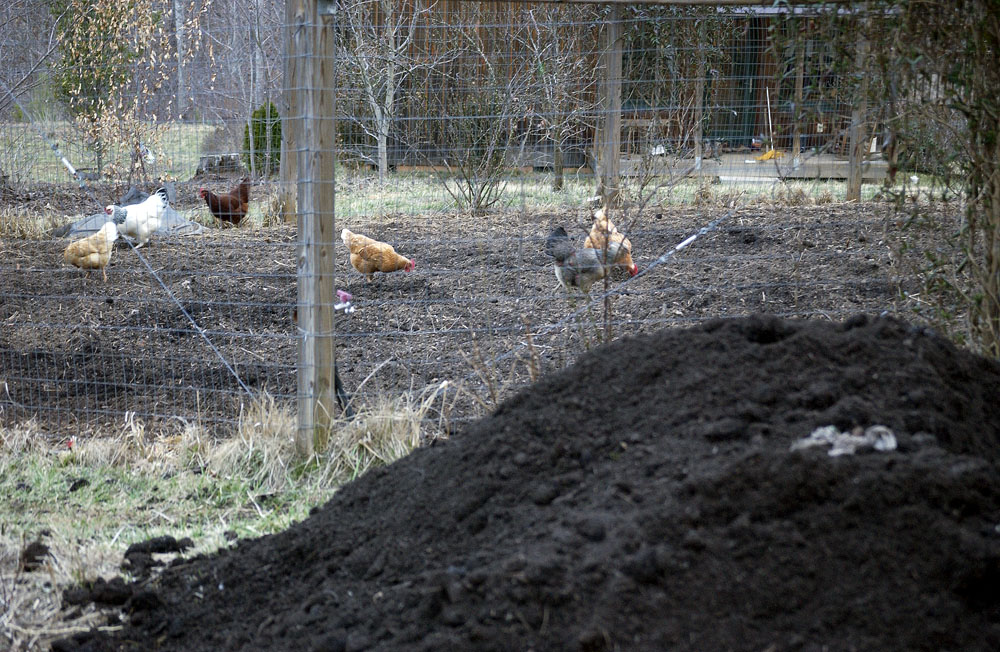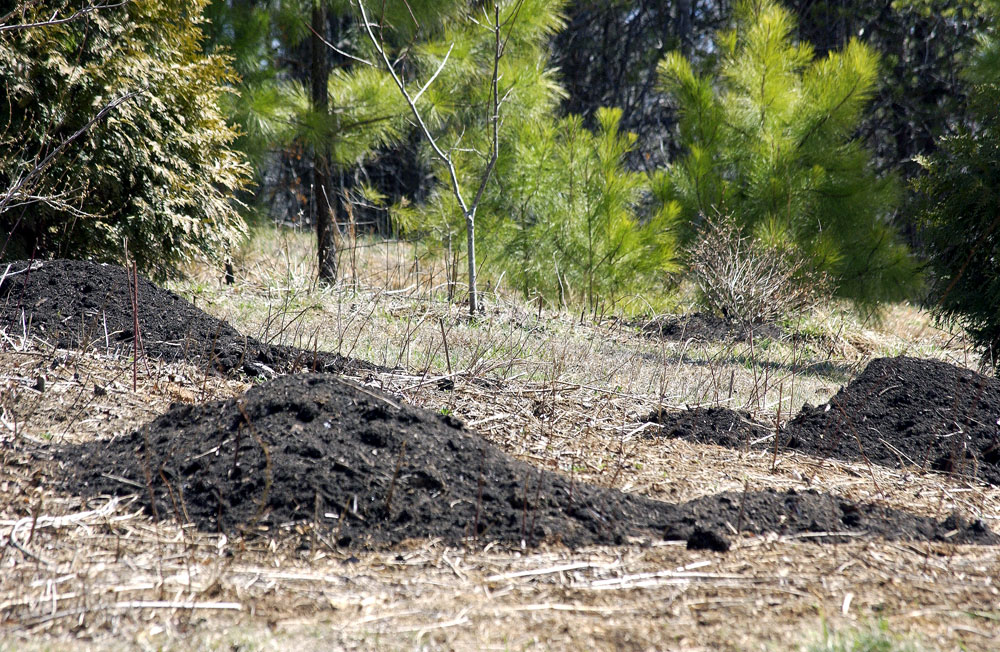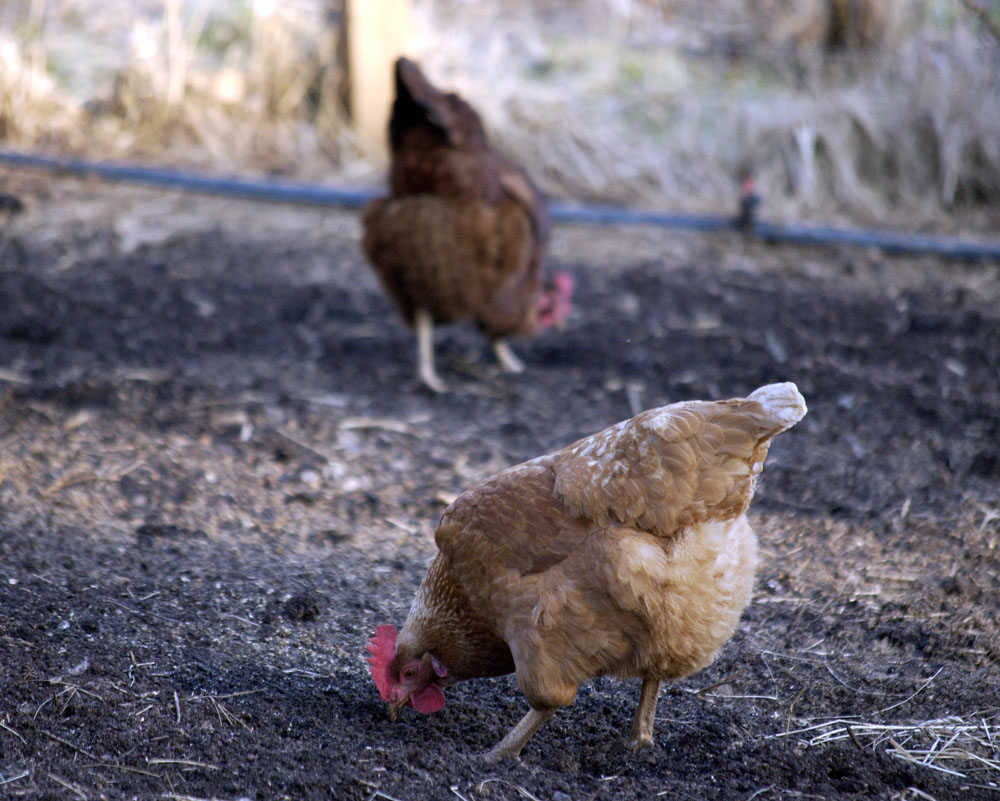The long-range forecast calls for normal-ish temperatures and above-normal precipitation, so Ken planted the early garden today.
Spring has sprung.
I hope.
Watching a bewildering world from the middle of nowhere
Spring is late. And who knows if it’s here for good. Last year, the Carolina jasmine bloomed all winter. This year, it’s still dormant. The grass and clover keep trying to make a start, but a cold snap always seems to shut it down again.
But a couple of things are blooming — the old-faithful daffodils, and the peach trees. As for the dandelion greens, they’ll go into a salad.
We picked up two new chickens today at the mill in Walnut Cove. They’re both Golden Comets.
Luckily, we’ve not lost any hens in the last year, so we figured that two new hens would suffice for 2014. Counting the two new girls, there are now eight chickens at the abbey. We got Golden Comets because of their sweet personalities and the fact that they’re efficient layers.
As usual, they will live in a big bird cage in the bay window until they’re old enough to go out to the chicken house and hold their own with the big chickens.
Last week, Ken told me that he saw eggs at Whole Foods that cost more than $10 a dozen. I just had to see that for myself, so today I looked for them in the egg section. The most expensive eggs I saw were $7.99 a dozen. But, luckily, Whole Foods’ egg guy was there refilling the shelves, and I got to ask him some questions.
Yes indeed, he said. Last week they had eggs that cost more than $10 a dozen. But they already had sold out! I asked him what it was about the eggs that justified the price. He called this the “resume” of the eggs. The $10 eggs, he said, were (if I and he understood correctly) from grass-fed hens. Both he and I found that a bit strange. Grass-fed cows are a good thing, because cows are ruminants, and grass is their natural food. It’s different with chickens, though. Chickens do love grass, but it’s not something that they want to live on exclusively. From my reading on chicken husbandry, I understand that chickens will happily derive about a third of their calories from grass. But they also want seeds and any tasty worms, grubs, or insects that they can find. Not to mention kitchen scraps. So I’m skeptical about the concept of grass-fed chickens.
Today, the most expensive eggs at Whole Foods were the $7.99 eggs, and I understood that the $7.99 eggs came from the same North Carolina farm (in Durham) that the $10 eggs came from.
But this is amazing. People will pay more than $10 a dozen for eggs! Ken and I really wanted to sample those eggs, because we both believe that they couldn’t possibly be superior to the eggs laid by Acorn Abbey’s happy pastured hens. But that test will have to wait. So far, the Whole Foods guy said, they have not been able to get more of the $10 eggs, though they’re trying.
Ken keeps a spreadsheet that he calls “Abbey economics,” and in the spreadsheet he tracks the cost of keeping our hens vs. the value of the eggs. One thing is for sure. The abbey’s economics look a whole lot better if you value our amazing eggs at $10 a dozen. At that price, we’re probably saving money by having our own hens.

The garden plot with compost freshly tilled in … and the chickens working it
Increasingly we think less in terms of fertilizing plants and more in terms of feeding the worms, on the grounds that if your worms are abundant and well fed, the plant life will flourish.
Part of this process is compost. The only form of compost easily available here at reasonable prices is leaf compost. This is a high-carbon compost and needs time to digest into the soil. But it’s good worm food if applied at the right time. Now is the right time. The soil is starting to warm up, and we’re a few weeks away from spring planting. Rain is forecast for Sunday. So Ken rushed to get several tons of compost spread around ahead of the rain. Then he tilled it into the soil. Given two or three weeks, a little rain, and a little warm sun, the compost will decompose into the soil before the spring planting.
My understanding is that high-carbon compost like leaf compost must be digested by bacteria before its nutrition is available to plants. While the bacteria are doing this work, they suck up a lot of nitrogen from the soil. Then the bacteria die, releasing the nitrogen back to the soil and making the nitrogen available for plants.
We also applied about 400 pounds of organic fertilizer this year. The fertilizer is made from chicken manure. But in addition to that, we use soybean meal (about 600 pounds this year) as fertilizer. The soybean meal has a decent portion of nitrogen, and it’s good worm food.
Each year, we add organic fertilizers and humus to the soil. And, each year, the plant life gets more lush and the birds and wildlife more exuberant.

Piles of compost ready to be tilled into the wildflower patches. The wildflower patches look nice, and the seeds the flowers produce attract birds.
As of sunset today, the chickens’ new habitat is ready. They now have three grazing and scratching areas, each separated by gates: the garden, the orchard, and a section of woods. Six chickens can do a great deal of damage to grass, and we want the strongest possible turf in the orchard. When it became apparent by mid-winter that the turf in the orchard was not going to be able to withstand a full winter of scratching, we moved the chickens into the garden to protect the orchard turf. The chickens soon wiped out the winter rye that had been planted as a cover crop for the garden and made a big mess. But at least, in the garden, no permanent harm was done.
Ken made the decision to extend their scratching area into the woods. That will give the chickens a great deal more space and relieve the pressure on the orchard turf. It also will provide a cool, shady area for the girls to hang out during the heat of summer. It also will make it easier to justify two or three new hens this spring.
This project cost several hundred dollars and a lot of time, but after we saw eggs for more than $10 a dozen at Whole Foods, we had no doubt that it was worth it.

The girls in the garden — now a muddy mess after lots of rain and snow and scratching
Previously in this blog I’ve expressed the opinion that the prevalence of gluten intolerance is exaggerated. Less than 1 percent of the population has coeliac disease. Still, gluten sensitivity seems to be increasing. Something must be going on. What could that be?
Recently I came across an article about a renegade MIT scientist who has a new theory about this. She thinks that the gluten problem is caused by glyphosate — that is, the herbicide Roundup, which is made by Monsanto and other companies.
I have no way of knowing whether this theory is valid. However, this scientist mentions a fact that is new to me, and it’s shocking. That is that wheat farmers are spraying Roundup on their crops just before harvest, to dry out the wheat and make the harvest process easier for the combine machine.
When I first read this, I was skeptical that farmers would do anything so obviously dangerous. But a little Googling shows that, not only is it true, Monsanto promotes this use of Roundup as a way of boosting combine output by up to 30 percent. How long Roundup persists on plants and soil after it is sprayed is highly variable. Under some conditions, it takes months for it to break down. When Roundup is sprayed on a field to clear weeds before planting, there probably is usually time for the Roundup to mostly break down before the crop reaches our kitchens.
However, if Roundup is sprayed on wheat three or four days before harvest, you can be very sure that it remains in the wheat, and therefore in the flour, until we eat it.
I take two lessons from this.
First is that our industrialized farmers cannot be trusted. If poisoning us yields them higher profits, then they’ll poison us. Unless we’re paying attention, we won’t know what they’re doing.
Second is that, from now on, I will use only organic wheat.
It’s shocking how the abbey grounds soak up compost. I long ago lost count of the total number of truckloads of compost that have been delivered here. It’s used for mulch and to loosen the soil when trees and shrubs are planted, plus a large amount of compost is tilled into the garden each year. The soil eats it, and it seems to vanish. But surely it’s still around in some form, feeding the earthworms. This is leaf compost, which is not the most nourishing compost in the world. But the earthworms eat it and never complain.